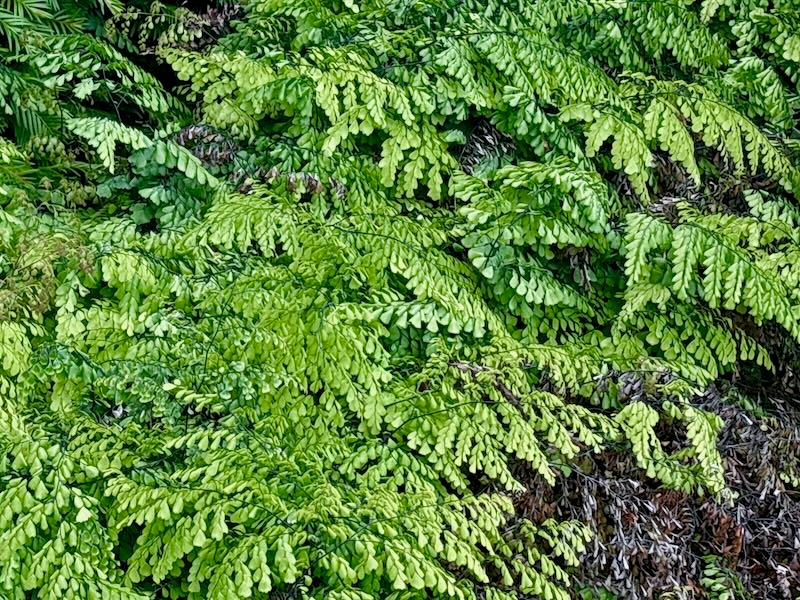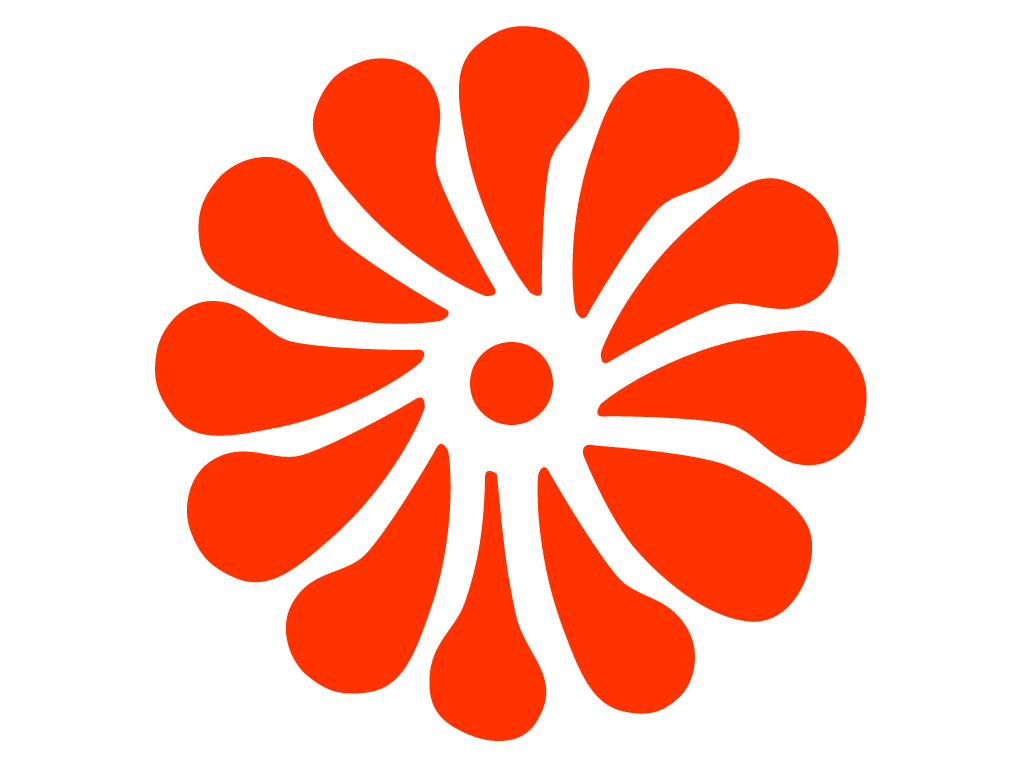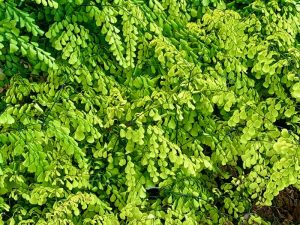Velvet Lace For Shade: Grow Adiantum venustum (Himalayan Maidenhair Fern)
Adiantum venustum brings fine texture and quiet movement to shade. This Himalayan Maidenhair Fern, in the Pteridaceae family, spreads into a soft, evergreen (or semi-evergreen) mat of lacy fronds held on black, wiry stems. Gardeners also know it as Evergreen Maidenhair and Black Hansraj. In spring, new croziers unfurl with a bronze-pink flush, then settle into cool green. Plant it where you want calm groundcover, elegant edging, and year-round interest in mild climates. Give it even moisture and shelter from harsh sun. In return, it will knit a shady bed together like living lace.
What sets Adiantum venustum apart
Many maidenhairs look delicate yet ask for tropical humidity. Adiantum venustum breaks the stereotype. It handles real winters and still keeps its poise. In USDA Zones 5–8 it proves hardy; in milder winters it stays evergreen, while in colder snaps it goes deciduous and returns strong in spring. The species grows from creeping rhizomes, so it fills gaps, but it does so politely. Unlike tall clumping ferns, it stays low, which makes pathways feel wider and mixed borders look finished at ground level. Its black stipes (stems) read like ink strokes under fan-shaped pinnae, adding contrast you can read from a distance.
Adiantum venustum size, habit, and texture
Expect a low, spreading carpet. Mature frond height usually ranges 15–25 cm (6–10 in), with a spread of 60–90 cm (24–36 in) over time; in ideal woodland soils, colonies can extend farther. Fronds are triangular and finely divided into small, fan-shaped segments. The plant creeps via shallow rhizomes just below the soil surface, weaving around stones and roots. New growth emerges early, often while other shade plants still sleep, so it gives beds an early “finished” look.
Where Adiantum venustum comes from
This species is native to the Himalayas and adjacent regions from Afghanistan and Pakistan across India, Nepal, Bhutan, and into western China and Myanmar. In the wild it grows in humus-rich leaf litter, on moist rock faces, and along cool forest margins. That origin explains its needs: constant moisture, sharp drainage, and shade with moving air. The Latin name Adiantum refers to the frond’s water-shedding surface (“not wetting”), while the specific epithet venustum hints at charm and grace.
Flowering? Not exactly—spores and seasonal interest
Ferns do not flower. Instead, Adiantum venustum makes spores on the frond undersides. Even without blooms, it earns attention through seasonal color shifts. New fronds open bronze to salmon, then turn light green and finally settle into a rich, cool green. In mild winters, fronds persist and may fade to olive or russet before spring replaces them. In cold winters (below about −20 °C / −4 °F), expect full dormancy; the rhizomes stay safe below mulch and push new croziers as soil warms.
Design ideas with Himalayan Maidenhair Fern
Use this fern as the “glue” between showier plants. Tuck it under Hostas, Heucheras, Astilbes, and Hydrangeas to hide bare stems and unify a planting. Line shady flagstone paths so the black stems and fine fronds trace the stone edges. Plant at the feet of shrubs like Camellia or Rhododendron to soften their bases. In small gardens, repeat patches every 60–90 cm (24–36 in) to create rhythm. In containers, combine it with Blechnum, small Hakonochloa, or trailing ivy for a lush shade bowl. The fan-shaped leaflets also catch raindrops and dew—perfect near seating where you will notice those details.
Site and climate fit
Choose cool shade or dappled light. Morning sun is acceptable in cool climates, but avoid strong midday or late-day sun, which scorches fan tips. Shelter it from drying winds. In Zones 5–8, plant it in the ground; in hotter zones, grow it in containers or deep shade pockets with extra humidity. It appreciates consistent moisture and cool roots. If your site has hot summers, pair with taller plants that cast light afternoon shade.
How to Grow Adiantum venustum
Use the steps below to establish a long-lived colony. Short, direct instructions keep tasks clear and help you troubleshoot early.
Light
Provide partial to full shade. Aim for bright, indirect light or high dapple. In cool coastal climates, brief morning sun is fine. In continental summers, protect from sun after 10 a.m. Indoors, place near an east or north window with filtered light. Avoid dark corners; low light reduces vigor and invites pest issues.
Soil
Plant in humus-rich, well-drained soil that stays evenly moist. Ideal pH runs slightly acidic to neutral (about 5.5–7.0). In clay, open the texture by mixing in 5–8 cm (2–3 in) of leaf mold, composted bark, or fine pine fines. In sandy soils, increase organic matter to hold moisture, then mulch. Keep the crown just at soil level so new fronds emerge freely.
Watering
Keep moisture steady. In the ground, aim for about 2.5 cm (1 in) of water per week from rain or irrigation, more in heat waves. Do not let soil dry out fully; fronds crisp quickly. Water early in the day so foliage dries by evening. In containers, water when the top 1–2 cm (½–¾ in) feels dry. Use room-temperature water to avoid shock.
Humidity
Raise humidity when growing indoors or in arid climates. Group pots together, set containers on pebble trays with water below the pot base, or run a small humidifier nearby. Outdoors, a dense mulch layer and nearby plantings help trap moisture around the leaf canopy.
Fertilizing
Feed lightly. In spring, top-dress with 1–2 cm (½–¾ in) of compost around the crown, then re-mulch. If growth seems thin, apply a balanced, water-soluble fertilizer at ¼ to ½ strength once a month from late spring to midsummer. Avoid strong, frequent feeding; too much nitrogen produces soft growth that collapses in heat.
Temperature & hardiness
Grow Adiantum venustum in USDA Zones 5–8 outdoors. It tolerates lows near −20 °C (−4 °F) with mulch. In mild climates it can remain evergreen. Ideal growing temperatures sit between 10–24 °C (50–75 °F). Heat above 30 °C (86 °F) stresses fronds; add shade and moisture during hot spells.
Planting & spacing
Plant in early spring or early autumn so roots establish in cool soil. Space clumps 30–45 cm (12–18 in) apart; they will knit together within two to three seasons. For edging, set plants 20–25 cm (8–10 in) from path edges so fronds just kiss the stone. Water in well, then mulch immediately.
Mulching
Mulch 5–7 cm (2–3 in) deep with shredded leaves, composted bark, or fine wood chips. Mulch keeps roots cool and conserves moisture, which this fern loves. Pull mulch back 2–3 cm (about an inch) from the crown to prevent rot. Refresh each spring after you tidy old fronds.
Container growing
Choose a pot 20–30 cm (8–12 in) wide with drainage holes. Use a peat-free, moisture-retentive mix blended with fine bark or perlite for aeration. Water when the top layer dries, and never allow the pot to sit in water. Feed at ¼ strength monthly during active growth. In hot climates, move containers into deeper shade in midsummer.
Indoor care
Place the plant where light is bright but indirect, humidity is high, and air is gentle. Bathrooms with windows or bright kitchens often work best. Keep drafts off fronds. Rotate the pot monthly so growth stays even. If air is dry, expect brown tips; increase humidity rather than overwatering.
Establishment timeline
Weeks 0–2: Water consistently; keep soil evenly moist.
Weeks 3–8: New fronds begin to appear. Maintain moisture and light feeding if needed.
First summer: Shade the crown in heat; do not let the root zone dry out.
Year two: Plants start to knit together. Reduce watering frequency slightly, but keep moisture steady.
Year three: A soft, continuous carpet forms. Divide small pieces if you want to expand the colony.
Propagation of Adiantum venustum
Divide established clumps in early spring just as new croziers emerge. Lift a section with a hand fork, teasing apart the shallow rhizomes. Each division should carry several healthy fronds and firm, white roots. Replant divisions at the same depth, water in, and shade for two weeks to reduce stress. Small divisions (8–10 cm / 3–4 in across) re-establish faster than very large chunks.
You can also sow spores, though it takes patience. In late summer, cut a fertile frond and place it in a clean paper bag until spores drop. Sprinkle spores over sterile, moist, peat-free seed mix in a shallow tray. Cover with clear plastic to maintain humidity and place in bright, indirect light at 20–24 °C (68–75 °F). First you will see a green film (the gametophyte stage), then tiny fernlets. Keep the surface evenly moist with a mister. Pot on when fernlets have several true fronds. The process can take months, but it’s rewarding if you enjoy propagation.
Pests & diseases on Himalayan Maidenhair Fern
Outdoors, slugs and snails may nibble new croziers. Hand-pick at dusk, use iron-phosphate baits where pressure is heavy, and avoid overhead watering in the evening. Scale insects sometimes settle on stems; remove small colonies by rubbing with alcohol-dipped cotton and improve airflow. In containers, mealybugs and fungus gnats can appear when soil stays too wet. Let the top layer dry slightly between waterings and use yellow sticky cards to monitor gnats. Indoors, spider mites are rare but possible in very dry air; raise humidity and rinse fronds gently in the sink.
Fungal leaf spots and rust can develop in prolonged damp, still air. Thin nearby foliage, water at soil level, and remove spotted fronds. Root rot is the main killer and results from poor drainage or constant saturation; correct watering rather than reaching for fungicides. Because fronds are thin, avoid oily sprays or strong soaps; test any product on a small area first.
Seasonal care calendar for Adiantum venustum
Late winter to early spring: Rake away tattered fronds and mulch. Divide if desired. Top-dress with compost and re-mulch. Watch for the first bronze croziers.
Spring: Maintain even moisture. Feed lightly if growth seems thin. Spot-water in dry spells.
Summer: Increase shade and irrigation during heat waves. Deeply soak the root zone in the morning. Clip out any scorched fronds to make way for fresh ones.
Autumn: Continue steady moisture until consistent rains arrive. In cold regions, add an extra 2–3 cm (¾–1¼ in) of leaf mulch after ground begins to cool.
Winter: In mild climates the fern stays semi-evergreen; tidy lightly. In cold climates, allow fronds to collapse and insulate the crown. Do not overwater dormant plants.
Troubleshooting: quick diagnoses and fixes
- Crisp brown tips: Air too dry or soil dried out. Raise humidity, water more consistently, and add mulch.
- Yellowing fronds: Waterlogged soil or poor drainage. Loosen soil with organic matter and reduce irrigation frequency.
- Sparse growth: Too little light or depleted soil. Move to brighter shade and top-dress with compost.
- Scorched patches: Direct sun or reflected heat. Increase shade, especially in the afternoon.
- Fronds flop after division: Divisions were too large or lacked roots. Next time, make smaller pieces with firm roots and shade them during recovery.
Wildlife and companion planting
While ferns don’t provide nectar, Adiantum venustum supports the garden’s ecology as cool, moist groundcover. It shades soil life, shelters beneficial insects, and moderates temperatures for neighboring plants. Underplant it below Camellia, Pieris, and Japanese Maples. Weave it around Hellebores, Tiarella, Brunnera, and Epimedium for layered spring texture. Its black stalks and fan leaves echo the structure of miniature ginkgo leaves, so it pairs beautifully with dwarf Ginkgo cultivars nearby.
Key measurements and facts at a glance
- Botanical name: Adiantum venustum
- Common names: Himalayan Maidenhair Fern, Evergreen Maidenhair, Black Hansraj
- Family: Pteridaceae
- Mature height: 15–25 cm (6–10 in)
- Mature spread: 60–90+ cm (24–36+ in) over time
- Hardiness: USDA Zones 5–8; evergreen in mild winters, deciduous in severe cold
- Light: Partial to full shade; bright, indirect light indoors
- Soil: Humus-rich, well-drained, consistently moist, pH 5.5–7.0
- Water: Even moisture; do not allow to dry completely
- Growth rate: Steady once established; spreads by shallow rhizomes
- Uses: Shade groundcover, pathway edging, woodland carpets, container understory
Final steps for success
Plant Adiantum venustum where shade stays cool and soil never swings from soggy to bone-dry. Build rich soil with leaf mold, then lock in moisture with mulch. Water deeply, lightly feed, and keep afternoon sun off the fronds. Divide small pieces in early spring to expand your planting. If you garden indoors, raise humidity and protect it from drafts. Do these few things, and Himalayan Maidenhair Fern will reward you with an elegant, low carpet that looks refined in every season.



